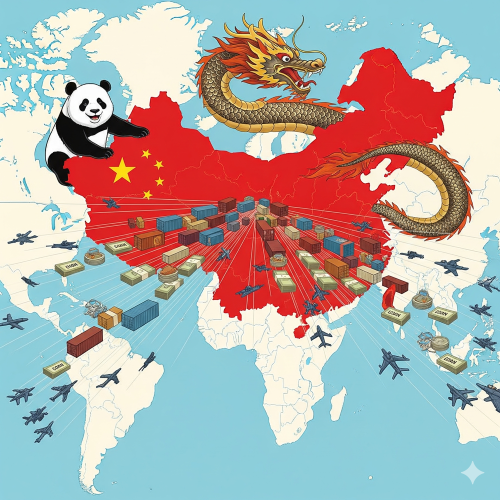What strategies are European governments considering to counterbalance China’s growing foothold in their markets and institutions?

European governments are considering a variety of strategies to counterbalance China's growing foothold in their markets and institutions.
These strategies are centered on reducing strategic dependencies, strengthening domestic industries, and enhancing a unified EU approach to China.
The overarching goal is to achieve "de-risking"—not a full "decoupling"—by diversifying supply chains and protecting critical infrastructure.
1. Strengthening Defensive Economic Tools
The EU is building a new set of economic and regulatory instruments to protect its market from what it views as unfair Chinese practices. These measures are designed to level the playing field and mitigate the risks posed by state-subsidized Chinese companies.
-
Investment Screening: The EU has established a framework for screening foreign direct investment (FDI) to identify and block acquisitions of critical European companies by foreign entities on national security grounds. While the final decision rests with individual member states, the EU's mechanism allows for information exchange and a common risk assessment. This is especially aimed at preventing Chinese state-owned enterprises from acquiring stakes in strategic sectors like ports, energy grids, and high-tech firms.
-
Foreign Subsidies Regulation: This regulation, which came into force in July 2023, empowers the European Commission to investigate foreign subsidies that distort the EU's internal market. It targets Chinese firms that may be unfairly outcompeting European companies due to state support, with the goal of ensuring a level playing field.
-
Anti-Coercion Instrument: This tool is designed to counter economic coercion from countries like China. It allows the EU to impose countermeasures, such as tariffs or market restrictions, against a country that tries to use economic pressure to influence EU policy decisions. The EU has also opened multiple anti-dumping and anti-subsidy investigations into Chinese products, including electric vehicles and solar panels, in response to concerns about state-subsidized competition.
2. Promoting Strategic Autonomy and Industrial Competitiveness
European governments are seeking to reduce their reliance on Chinese supply chains by bolstering their own industrial capabilities and promoting a more resilient economic model.
-
Critical Raw Materials Act: This act aims to secure a stable supply of essential raw materials, such as lithium and rare earths, which are vital for the green and digital transitions but are currently dominated by China. The legislation sets targets for the EU to increase its domestic mining, processing, and recycling of these materials and to diversify its sources from outside of China.
-
Net-Zero Industry Act: This initiative seeks to boost domestic manufacturing of green technologies, including batteries, solar panels, and wind turbines, to avoid a new dependency on Chinese-made products. It offers incentives and funding to support European companies in these sectors, promoting a "Made in Europe" approach to the green transition.
-
Diversification of Supply Chains: European companies are being encouraged to diversify their supply chains away from China to reduce vulnerability to geopolitical risks and supply disruptions. This involves building new trade relationships with countries in Southeast Asia, Latin America, and other regions. The EU's trade policy is also focused on negotiating new free trade agreements to facilitate this diversification.
3. Offering a Geopolitical Alternative to the BRI
Beyond internal measures, the EU is also projecting its influence globally by offering an alternative to China's Belt and Road Initiative (BRI).
-
Global Gateway Strategy: Launched in 2021, the Global Gateway is a major EU initiative that plans to mobilize up to €300 billion in investments for sustainable and high-quality infrastructure projects in developing countries. It is explicitly framed as a values-driven alternative to the BRI, prioritizing transparency, environmental standards, and the rule of law. This strategy is a key part of the EU's effort to maintain its geopolitical relevance and offer partner countries a development model that avoids the risks of debt dependency and a loss of sovereignty.
4. Enhancing Political Coordination
Recognizing that a fragmented approach to China is a weakness, EU governments are working to improve political and diplomatic coordination.
-
EU-Wide China Strategy: The EU has moved toward a more cohesive China strategy, officially labeling China as a "partner, competitor, and systemic rival." This framework provides a common language and a basis for collective action.
-
Increased Dialogue and Information Sharing: The European Commission and individual member states are holding more frequent meetings and dialogues to share intelligence and coordinate their responses to Chinese actions. This is particularly important for addressing issues like cybersecurity threats and foreign interference.
- Questions and Answers
- Opinion
- Motivational and Inspiring Story
- Technology
- Live and Let live
- Focus
- Geopolitics
- Military-Arms/Equipment
- Ασφάλεια
- Economy
- Beasts of Nations
- Machine Tools-The “Mother Industry”
- Art
- Causes
- Crafts
- Dance
- Drinks
- Film/Movie
- Fitness
- Food
- Παιχνίδια
- Gardening
- Health
- Κεντρική Σελίδα
- Literature
- Music
- Networking
- άλλο
- Party
- Religion
- Shopping
- Sports
- Theater
- Health and Wellness
- News
- Culture

